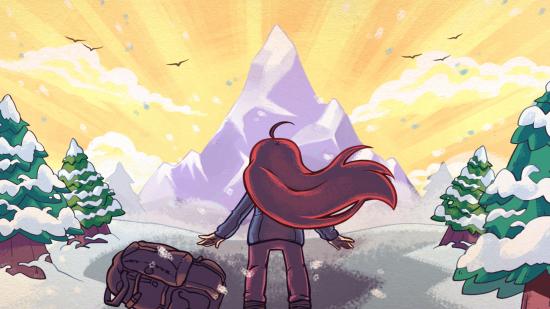Celeste is not my sort of game, and it certainly shouldn’t be my 2018 game of the year. The opening moments of this teeth-gnawingly difficult journey made me consider packing it all in at base camp. You see, I’m just not that good at platformers. I didn’t think I could cope with the intimidating level of dexterity and patience I’d need to see the credits roll in the latest from Matt Makes Games. Actually, I knew I couldn’t.
You could say Madeline and I had something in common as we embarked on our adventure to reach the peak of Mount Celeste. Soon after the basics of jumping, dashing, and climbing walls I learned that, beneath the protagonist’s vibrant shock of crimson locks, an internecine battle rages.
Madeline’s most fearsome foe is not a bottomless chasm or floating, tentacle-infested platform, but herself. Soon you’ll realise that Madeline’s real mission is coming to terms with her crippling anxiety, depression, and self-doubt.
In your journey you’ll find an ornate mirror that beams a reflection of you with purple hair and piercing red eyes. Your demonic double, Badeline, then breaks free from her reflective prison. She is all of our main character’s fears and worries made manifest; an omnipresent spectre looming over everything. She’ll indefatigably pursue you through intricately designed mazes until you submit to the corner of your psyche that tells you, ‘No, you can’t do this’. There will be times when you believe her.
Read more: Jacob’s game of the year is Life is Strange 2
Celeste demands total mastery of its controls. However, opportunities to best the insurmountable are baked into the game’s design through instant reloads and mostly generous checkpointing. A split second after you’ve succumbed to your hundredth or thousandth demise you’ll be back in the action immediately.
From there, the only thing getting in the way of having another go is you. With practice and determination you’ll amaze yourself with feats of agility you’d have thought impossible at the beginning. This stop-start rhythm is a natural extension of the story, reinforcing the sternness of the seemingly Sisyphean task in front of you.
Where some games may tack on a narrative because the designers feel like one should be there, Celeste’s tough loop is the best means of telling its story. All of its mechanics illuminate Madeline’s mental state – like the breathing minigame. To calm a panic attack, she pictures a feather in her mind. The more you keep it in the safe area, the more the highs and lows become less pronounced, the creepy trance tunes mellow out, and Madeline’s breathing settles.

Then there’s the final confrontation against your bad self, which ends with you back at the base of the mountain with no way back up. Badeline is not blasted into oblivion to be forgotten and tucked away, but remains a part of Madeline – giving you the ability to double jump. It’s the existence of Badeline that enables the two of them to succeed in their task. In other words, Madeline is ultimately able to reach the peak of Mount Celeste not in spite of her mental health, but because she turns to face it.
Related: Jump on the best indie games on PC
Ostensibly, Celeste is a game about climbing its eponymous mountain. But, really, it’s a metaphor for any obstacle, physical or otherwise. Celeste shows that you can do anything with the necessary persistence, whether your mountain is scaling Everest or just getting out of bed in the morning.
